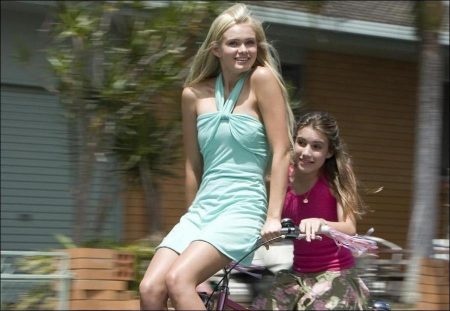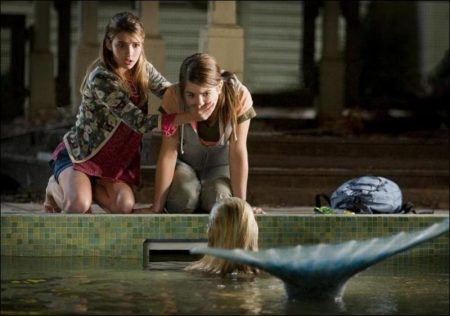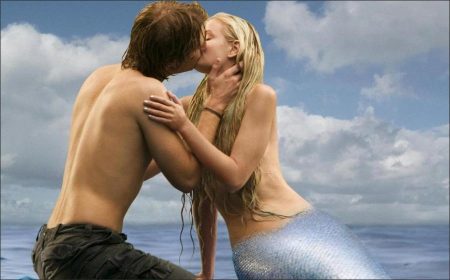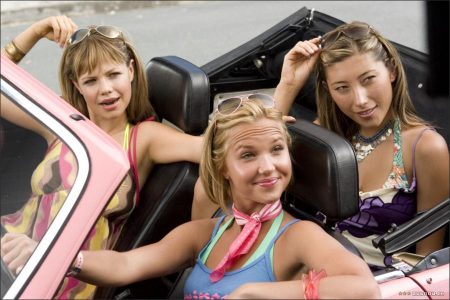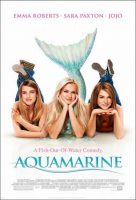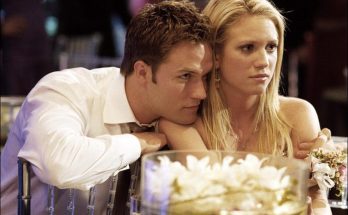Aquamarine Movie Trailer. For Raymond, the hunky lifeguard and Aqua’s love interest, Allen and Cartsonis auditioned many young actors until they zeroed in on one who had not only the requisite heartthrob looks, but the unique sense of humor needed to keep up with Sara Paxton’s quirky comedic abilities. Notes Elizabeth Allen: “When Jake McDorman walked in to audition, he was cracking jokes and was refreshingly wild. He found an approach to Ray’s lines that was completely different than we imagined, and it impressed us immediately.
The filmmakers faced several challenges when selecting the shooting locations. Production was restricted to Emma Roberts’s and Sara Paxton’s February-to-May television series hiatuses, so it was impossible to shoot the summer-set story in the script’s original Northeastern U.S. setting. Locations all over the country, including sites in Louisiana, Florida, and California, were scouted to accommodate the scheduling issue, but ultimately the perfect spot was found halfway around the world, in Australia.
The continent’s Gold Coast, as scenic and adaptable as it was, looked too tropical to double for, say, Massachusetts, so the filmmakers changed the story’s American location to Tampa Bay. This meant recreating Florida’s Gulf Coast in Australia, specifically the sleepy beach town of Tallebudgera, Queensland, which is located about 45 minutes south of Brisbane.
This huge task fell to production designer Nelson Coates, who designed such films as Antwone Fisher and Runaway Jury, and the ABC miniseries Stephen King’s The Stand (for which he was Emmy-nominated). His mission was to create a magical world where Claire and Hailey could discover a beautiful mermaid. “We wanted that sense of familiarity and timelessness that a small-town feel would bring to the story,” explains Coates. “We had to come up with a vibe and a place that could support the reality of this idyllic summer.”
The primary set was the Capri Beach Club, in what became the movie’s fictional “Baybridge, Florida.” It’s where Claire lives with her grandparents, where lifeguard Raymond works and causes the town’s girls to gather, and where the displaced mermaid Aquamarine surfaces. The crew scouted a number of existing beach clubs in the area, but none suited the story, which required a kind of relaxed, retro, East Coast American style. None of the local clubs had a swimming pool, so the filmmakers built a new one from the ground up, because the right pool was critical to the story and for the key “reveal” of the mermaid. Coates ended up designing the swimming pool first, then fashioning the entire beach club around it.
Because the beach club was created on the Gold Coast’s King Tide line, the set had to be specially built so it wouldn’t wash away when the big tides came through. It had to be constructed to withstand the severe winds and water of a potential cyclone, not uncommon in the area. “We were right on the beach,” explains Coates, “and with weather that could turn on a dime, the buildings had to be strong enough not only to survive the elements but also to hold the cranes and other equipment crucial to every day’s shoot.”
Aside from the “big picture” of Coates’ design, he also had to stay attentive to the smaller details that would truly evoke the Florida coast. “We kept focused on those specifics native to the Tampa Bay area, such as signage, sand fencing made of little pieces of wood and wire mesh, palm trees, and left-hand drive vehicles,” says Coates. “These things are all common in Florida, but quite unusual in Australia.”
Also common in Florida but virtually non-existent in Australia are water towers like the one Aquamarine hides in over the course of the movie. Coates and his crew had to build their own, which was not without its complications. “Due to safety concerns, we ended up building individual sections of the tower, as opposed to one whole structure,” recalls Coates. “We assembled a 28-foot base, including the tower legs, then built the lower portion of the tower for stunt work.”
For the scenes that would take place around the storage tank at the top of the tower, Coates built a huge cistern on a separate set, then created the inside of the water tank at a nearby studio. “We ultimately married the two to make them look like they were all one complete piece, so it took a bit of logistics, a bit of clever geometry to pull off,” declares the designer.
Color also played a major role in the creation of the sets as well as in the overall visual look of AQUAMARINE. Given the significance of the ocean throughout the film – narratively, thematically, and physically – a fusion of sea-themed colors, predominately blues and greens, dominated the movie’s color palette. Coates and director of photography Brian Breheny, ACS worked in tandem to incorporate this color scheme into every level of the film’s design including paints, fabrics, costumes, cinematography, and even the mermaid’s tail.
Cinematographer Breheny was keen to bring a glamorous, pastel-like quality to the film, reminiscent of the classic, American beach club environments of the 1940s and ‘50s. To reproduce this feel, he raked light along wood-paneled walls to highlight shape and texture, and backlit the set wherever possible.
Also working within the film’s clearly defined color palette was costume designer Sally Sharpe. “I tried to create a wardrobe that was believably American in a sort of ‘Miami colorful’ way,’” says Sharpe. “I wanted the clothes to be bright, clear, tropical, even a bit Caribbeaninspired.
“At the same time,” she continues, “I had to think a bit out of the box and anticipate what girls might be wearing a year ahead, when the movie will be released. The good news on that, however, is that the characters live in a small town, so their clothes don’t have to be completely cutting edge.”
Sharpe made sure each character’s personality and development was reflected in their clothing. “For example, Claire wears light pink to represent her feminine, controlling nature, while I put Hailey in earth tones because she’s more of a salt-of-the-earth tomboy, more of a skate chick. However, their clothing loosens up somewhat as the story progresses.”
The costumer continues, “Cecilia, the ‘mean girl,’ wears brighter pinks and corals– accessorized by her hot pink sports car–with these bolder, primary colors signifying danger.”
And, whereas Cecilia and her posse are decked out in trendier clothes and accessories, mermaid Aqua goes in the complete other direction, unaffected by fashion. “Her clothes mirror her underwater life,” says Sharpe, “which meant dressing her in various shades of blue, green, and even purple.” As for young heartthrob Jake, “I put him in rugged as well as softer, more colorful surfer clothes. In truth, he looked good in anything he wore.”
Certainly the biggest costuming challenge was the creation of Aquamarine’s tail, a task undertaken by Jason Baird’s Gold Coast-based company JMB FX Studio, which had previously worked on the two Matrix sequels; Star Wars: Episode Two – Attack of the Clones; and House of Wax. “The tail had to be very realistic,” says Baird, “an extension of Aquamarine herself; sleek and sexy, yet subtle and delicate in movement.”
JMB FX Studio created a tail simulating real fish scales with a sleek line that hugged the natural curves of the female body. Unlike any mermaid tail ever seen on the big screen, over 5000 individual scales were hand-painted and hand-laid on each of four tails required for filming (including the “hero” tail, worn only by Sara Paxton; a stunt tail; a skirt section for upper body shots; and an animatronic tail that moved more fluidly and gracefully than the hero tail).
Each tail was designed to fulfill the requirements of specific scenes. For instance, at the beginning of the film, Aquamarine performs back flips in the air, to the delight of Claire and Hailey. To create this effect, the JMB FX team built a rotating rig onto which Paxton, as well as the animatronic tail, was strapped. The actress and her “tail” were then filmed in the studio against a green screen with the animatronic portion remotely operated by puppeteers.
“For a more modestly-budgeted movie, we have some huge special and visual effects, not the least of which is Aqua’s fabulous animatronic tail,” observes Susan Cartsonis. “I’m not saying that AQUAMARINE is a big effects extravaganza, but it has some of the effects you need in a big movie, like the transformation of Aqua’s legs into a tail, or a scene where the mermaid is pulled out to sea. “Having Jason Baird’s brilliantly talented creature shop on our team was an enormous plus. He’s an effects designer of the first order.”
Of course, the person who was most “connected”–literally and figuratively–to the animatronic tail was Sara Paxton, who plays free-spirited mermaid Aquamarine. Each day the actress would have her “tail” glued-in, which necessitated her being carried by stretcher from the prosthetics bus to the set. This was on top of the many hours it took in hair, make-up, and costumes to become a mermaid.
Though it was a grueling process, Paxton took it in stride. “This may sound weird, but growing up, I always wanted to be a mermaid,” says Paxton. “I don’t know, maybe it was because of how often I watched the movie The Little Mermaid. My cousins and I would play in my pool and pretend we were mermaids. Playing Aqua, I got to have blue hair and a blue tail, so how cool is that?”
Paxton also loved the movie’s themes of acceptance and being oneself. “It teaches that you don’t need to be someone else to get someone to like you,” the actress notes. “Despite all the techniques Aqua uses to attract Raymond, he ends up liking her for who she really is – someone who’s unique and quirky and kind of silly. That’s an important lesson to learn, especially for young girls.”
Emma Roberts, who plays the timid Claire, appreciated the film’s message of living life to the fullest. “Claire learns she can’t go through life being afraid of everything and not trusting people,” says Roberts. “She eventually realizes she has to go with her instincts more and enjoy life as much as she can, because it can be taken away at any second. To be able to figure that out at our age is huge.”
Actress/singer Joanna “JoJo” Levesque, who portrays Claire’s best friend Hailey, believes one of the movie’s great lessons is “how things don’t always go the way you plan; how you can find fun and friendship in unexpected places.” Levesque thinks the strong-willed Hailey also learns “not to be mad at the world, because the world is not out to get you. Actually, the world is there for you, if you let it be.”
Elizabeth Allen believes that the film’s major themes developed organically during the shoot. “Initially, I felt the movie was about individuality and embracing who you are as a person,” she says. “However, maybe because of the real, altruistic love that developed between Sara, Emma, and JoJo – and their on-screen characters – as we filmed, I realized the movie had evolved into a story about friendship. Ultimately, I’d say it’s a film about people standing up for each other and standing by each other through thick and thin.”
Aquamarine (2006)
Directed by: Elizabeth Allen
Starring: Joanna Levesque, Emma Roberts, Sara Paxton, Arielle Kebbel, Claudia Karvan, Tammin Sursok, Roy Billing, Julia Blake, Shaun Micallef, Natasha Leigh, Dichen Lachman
Screenplay by: John Quaintance, Jessica Bendiger
Production Design by: Nelson Coates
Cinematography by: Brian J. Breheny
Film Editing by: Jane Moran
Costume Design by: Sally Sharpe
Set Decoration by: Lenny Holmdahl
Art Direction by: Bill Booth
Music by: David Hirschfelder
MPAA Rating: PG for mild language and sensuality.
Distributed by: 20th Century Fox
Release Date: March 3, 2006
Views: 503
